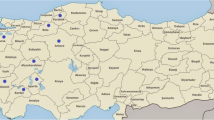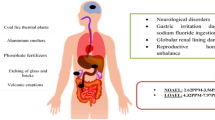Abstract
Abstract A variety of methods, including the Ion Selective Electrode (ISE), have been used for estimation of fluoride levels in drinking water. But as these methods suffer many drawbacks, the newer method of IC has replaced many of these methods. The study aimed at (1) validating IC for estimation of fluoride levels in drinking water and (2) to assess drinking water fluoride levels of villages in and around Vellore district using IC. Forty nine paired drinking water samples were measured using ISE and IC method (Metrohm). Water samples from 165 randomly selected villages in and around Vellore district were collected for fluoride estimation over 1 year. Standardization of IC method showed good within run precision, linearity and coefficient of variance with correlation coefficient R2 = 0.998. The limit of detection was 0.027 ppm and limit of quantification was 0.083 ppm. Among 165 villages, 46.1% of the villages recorded water fluoride levels >1.00 ppm from which 19.4% had levels ranging from 1 to 1.5 ppm, 10.9% had recorded levels 1.5–2 ppm and about 12.7% had levels of 2.0–3.0 ppm. Three percent of villages had more than 3.0 ppm fluoride in the water tested. Most (44.42%) of these villages belonged to Jolarpet taluk with moderate to high (0.86–3.56 ppm) water fluoride levels. Ion Chromatography method has been validated and is therefore a reliable method in assessment of fluoride levels in the drinking water. While the residents of Jolarpet taluk (Vellore distict) are found to be at a high risk of developing dental and skeletal fluorosis.





Similar content being viewed by others
References
Fluorides and oral health. Report of a WHO Expert Committee on Oral Health Status and Fluoride Use.—PubMed—NCBI [Internet]. 2016. http://www.ncbi.nlm.nih.gov/pubmed/7975675.
Passmore R, Nicol BM, Rao MN, Beaton GH, Demayer EM. Handbook of nutritional requirements. Monogr Ser World Health Organ. 1974;61:1–66.
WHO. Guidelines for drinking-water quality, third edition, incorporating first and second addenda [Internet]. 2016. http://www.who.int/water_sanitation_health/dwq/gdwq3rev/en/.
The Hindu: eight districts identified as fluorosis endemic [Internet]. 2016. http://www.thehindu.com/thehindu/2001/06/09/stories/0409223v.htm.
Susheela AK. Fluorosis management programme in India. Curr Sci Bangalore. 1999;77:1250–6.
Michalski R. Ion chromatography as a reference method for determination of inorganic ions in water and wastewater. Crit Rev Anal Chem. 2006;36:107–27.
Small H, Stevens TS, Bauman WC. Novel ion exchange chromatographic method using conductometric detection. Anal Chem. 1975;47:1801–86.
IC Application Note No. S-198, Metrohm- Google Search [Internet]. 2016. http://partners.metrohm.com/GetDocument?action=get_dms_document&docid=696143.
Sharma N, Tiwari S, Saxena R. Ion chromatographic techniques for detection of inorganic analytes in biological, environmental and industrial samples–a review. 2016. http://data.conferenceworld.in/ICSTM2/P2042-2051.pdf.
International conference on harmonisation of technical requirements for registration of pharmaceuticals for human use, validation of analytical procedures: text and methodology Q2 (R1), ICH harmonised tripartite guideline. 1996.
CDFG Fish and wildlife water pollution control laboratory standard operating procedure for the determination of inorganic Anions in water by ion chromatography—EPA 300. http://www.cdpr.ca.gov/docs/emon/pubs/anl_methds/bio_298.pdf.
IC application note no. S-3, Metrohm - Google Search [Internet]. 2016. https://www.google.co.in/?gfe_rd=cr&ei=h0F9V92PFdCL8QebjIPIDg&gws_rd=ssl#q=IC+application+note+no.+S-3+AND+Metrohm.
Michigami Y, Kuroda Y, Ueda K, Yamamoto Y. Determination of urinary fluoride by ion chromatography. Anal Chim Acta. 1993;274:299–302.
Shanthakumari D, Srinivasulu S, Subramanian S. Fluoride Contaminated Water and its Implications on Human Health in Vellore District, Tamil Nadu, India. Res J Environ Toxicol. 2007;1:16–26.
Tamilarasi V, Murugesan S, Vishwanathan B. Groundwater quality monitoring in Walajah Block, in Palar river basin at Vellore District, Tamilnadu, India. Int Res J Environ Sci. 2015;4:33–41.
Acknowledgements
I gratefully acknowledge the Department of Clinical Biochemistry and Institutional Research Board of the Christian Medical College, Vellore for their financial support.
Author information
Authors and Affiliations
Corresponding author
Rights and permissions
About this article
Cite this article
Bondu, J.D., Selvakumar, R. & Fleming, J.J. Validating a High Performance Liquid Chromatography-Ion Chromatography (HPLC-IC) Method with Conductivity Detection After Chemical Suppression for Water Fluoride Estimation. Ind J Clin Biochem 33, 86–90 (2018). https://doi.org/10.1007/s12291-017-0642-9
Received:
Accepted:
Published:
Issue Date:
DOI: https://doi.org/10.1007/s12291-017-0642-9




